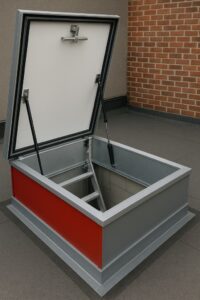
It’s easy to assume all roof doors serve the same basic purpose. Just a way to get up to the roof, right? But that’s exactly where a lot of people go wrong.
Choosing the wrong type of roof door can turn into an expensive mistake. From safety risks to compliance issues, the wrong decision affects more than just access. It can impact energy use, long-term maintenance costs, and even how safe your building is during an emergency.
If you’re planning, replacing, or just evaluating roof access for your building, make sure you’re not falling into these common traps.
Ignoring Building Codes and Compliance Rules
One of the most overlooked parts of choosing a roof door is making sure it follows building code requirements. These rules vary depending on the type of building, its location, and its intended use. But the consequences of ignoring them are the same: failed inspections, added costs, and sometimes having to start over.
Building roof doors often need to meet fire rating standards, insulation benchmarks, and size regulations. In some buildings, they’re also considered part of the emergency egress route, which brings in even more requirements. It’s not just about buying a door that fits the opening. It’s about choosing one that fits the law.
If you’re unsure, this is one area where it’s worth getting expert input. Retrofitting a non-compliant roof door later is rarely simple or cheap.
Choosing the Wrong Size or Putting It in the Wrong Spot
This one might seem obvious, but it’s a surprisingly common mistake. People often underestimate how much space they’ll need for routine roof access, especially when equipment or tools are involved.
If the opening is too small, it becomes awkward and sometimes dangerous to move things through it. If it’s installed in a bad location, it can get in the way of mechanical units, HVAC systems, or drainage areas. This creates maintenance headaches and potential damage over time.
Size and placement aren’t just about convenience. They also affect safety. A poorly placed roof door can lead to unsafe ladder positioning or awkward maneuvering, which increases the chance of falls or injury.
Overlooking Weather Resistance
A roof door is constantly exposed to the elements. It deals with wind, rain, heat, cold, and in some cases, snow and ice buildup. Choosing a door that isn’t built for those conditions is asking for problems.
Water leaks are a big issue when weather resistance is ignored. Without sealed edges or proper drainage, moisture can make its way into the building. That opens the door (literally) to interior damage, mold, and structural decay.
Even the materials matter. If the door isn’t made with corrosion-resistant components, it won’t take long before rust becomes an issue. Once rust sets in, it often spreads to surrounding components, affecting hinges, locks, and even roof integrity.
If you want the door to last, it has to be built for the climate it’s in.
Going for the Cheapest Option
Everyone has a budget. But this isn’t the area to make cost your top priority. Cheap roof doors usually come with a few familiar issues: poor insulation, flimsy construction, low-grade materials, and a lack of safety features. These things might not be obvious right away, but they tend to show up within the first year or two of use.
You don’t need to go overboard or pay for features you’ll never use. But you do need something that’s solid, secure, and built to handle frequent use. A few extra dollars upfront often means fewer problems down the line, and a lot less time spent on repairs or replacements.
Ignoring Built-In Safety Features
There’s a big difference between roof access that’s technically possible and roof access that’s genuinely safe. If you’re dealing with maintenance teams, equipment deliveries, or even occasional inspections, safety features make a major difference.
Gas spring assists help keep doors from slamming shut. Interior release mechanisms prevent people from getting trapped. Anti-slip surfaces reduce the chance of accidents, especially when the roof is wet or icy. And secure locking systems control who has access and when.
In commercial buildings or properties with multiple tenants, these features aren’t just smart — they’re essential. Leaving them out creates unnecessary risk, and that’s something property managers and owners often regret.
Forgetting Insulation
This is another hidden issue. A roof door that lacks proper insulation becomes a weak point in your building’s thermal envelope. That means conditioned air escapes more easily, and outdoor temperatures come in.
Over time, this increases the strain on your HVAC system and raises energy bills. It can also create uncomfortable temperature swings inside the space directly below the roof.
Well-insulated roof doors often include a thermal break in the frame and a fully insulated core. These features aren’t always obvious at first glance, but they make a difference in energy performance and building comfort.
Using the Same Style for Every Building
Not all roof doors are designed the same. What works for a warehouse may be completely wrong for a school, hospital, or residential property.
If your building sees frequent roof access, a stair-access model may be the best option. If space is tight or use is infrequent, a smaller ladder-access hatch might be more appropriate. And if you need to bring equipment up to the roof regularly, you’ll probably need a double-leaf design to handle the load.
Each type has a different footprint, different structural needs, and different safety requirements. Assuming that one standard model works across all building types is a shortcut that often leads to regret.
Get It Right from the Start
Choosing a roof door isn’t a minor decision. It touches everything from safety to energy use to maintenance logistics. And once it’s installed, fixing the mistakes is rarely easy or cheap.
Take the time to think through how the door will be used, who will use it, how often, and under what conditions. Factor in climate, compliance, and the layout of your roof.
When you get those details right upfront, the result is a roof access solution that works well, lasts longer, and doesn’t cause problems later on. That’s exactly what you want — out of sight, out of mind, but always ready when you need it.






